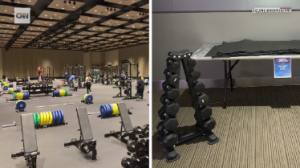
Hello TVD Friends,
I wish our CV🦠News had some new news to report on our COVID vaccine availability, but alas, no. We continue to request a vaccine allocation weekly to cover those of you who are, or recently (March 15) became “tier eligible”, but challenges with vaccine supply continue to stymie us. We were, however, able to get all 100 of our “second doses” for those we immunized last month. Thanks again to our friends at the County!
Limited vaccine supply continues to be a source of frustration, not made any better by these two articles in recent news: “Californians 50 and older eligible for vaccine on April 1” announces the State reported by the Almanac News, but then Palo Alto Online reports, “…supply of COVID-19 vaccine doses plummets…”. You can see the Catch-22.
What does all of this mean for you? We don’t really know for certain, but I suspect that TVD will not be able to obtain new “first doses” of COVID vaccine, and that for those of you still waiting you will likely need to turn to “MyTurn”, pharmacy chains or large scale medical facilities to schedule your vaccine. We do have good news, though, and it is two-fold; one, organizationally these scheduling systems are getting better, and two, there should be a very significant upsurge in vaccine supply over the next couple of weeks.
Fingers crossed!
On to our newsletter! There is much to read regarding, no surprise, COVID, including updated recommendations regarding testing, and several interesting pieces on the COVID vaccine, with some updates on COVID vaccine in children.
If you’ve read enough about COVID for today, and want to simply get out of this world, then read on for some news about the Mars Rover, Perseverance. Take a minute and pause to really think about this, we’ve put a “rover” on Mars (and you can “hear”, for the first time ever, sounds from another planet (!)). If that is not amazing enough, in the next week or two there’ll be news about the first powered aircraft flight on a planet beyond Earth.
Wow.
Eric Weiss, MD, March 25, 2021

NOTE: CV🦠News is a labor of love. If you enjoy reading this, please share widely! Was this forwarded to you by a friend? Please subscribe here.


Private voice teacher and Stanford lecturer, Nova Jimenez, has been performing what she calls “sidewalk serenades” for front-line and essential workers and isolated seniors around the Bay nearly every weekend since last May! “I think the work I’m doing right now, it’s my most important purpose in life,” said Jimenez, who has been singing professionally since she was a child. “We’re living in all these restrictions and to be able to do one little thing without endangering people, it is freeing”. Watch her cover of “Light of the World” from “Godspell” here!

The short answer is: after known exposure, it is technically not very helpful to test for COVID until you develop symptoms. With the incubation period extending up to 14 days, prior to that 14-day point a negative test doesn’t tell us much as the result could still become positive later. If you develop symptoms, a test can then help to determine if you should continue on the 14-day quarantine path or if you should switch to the isolation and care recommendations for those who have been infected.
When is your test, on average, most likely to be positive if you are infected? The answer to this is sometime between 5 and 8 days after exposure. We know that 50% of people who will develop symptoms do so by day 5 and we know that test sensitivity for detecting infection begins to decrease again sometime after day 8… Read more
Prerana Sangani, MD, March 23, 2021

Several recent studies on so-called ‘long-term COVID -19 symptoms’ have found that about 25% of people infected with the virus, even those who develop little to no symptoms associated with the initial infection, can suffer from persistent symptoms and impairment months after infection. In a new Stanford study of Bay Area patients who were never sick enough to require hospitalization, 29% of people who returned to their doctor for treatment 3-4 months after infection reported fatigue, 21% reported shortness of breath, 24% reported loss of taste or smell, 17% reported muscle pain and 16% reported memory problems. A multi-site study including University of California, Irvine found that long-hauler symptoms tended to cluster together in five groups, categorized in pairs: chest pain-cough, shortness of breath-cough, anxiety-fast heartbeat, abdominal pain-nausea, and low back pain-joint pain. People who experienced a certain symptom during their initial infection were more likely to report a related cluster of symptoms later on… Read more
Jennifer Abrams, MD, March 23, 2021

Because of COVID-19’s disproportionate risks for older populations, it’s understandable that vaccine developers have waited to conduct clinical trials on other lower-risk populations, like children. However, as early as the fall of 2020, groups like the American Academy of Pediatrics have recommended studies looking at the effectiveness of vaccines in children.
Moderna, Pfizer and Johnson & Johnson have all announced that clinical trials involving children were underway for their vaccines. If the vaccines are shown to be safe and effective, they could be approved for emergency use for children by the end of the summer of 2021. (All three organizations have said that they plan to first test the vaccines on teenagers and pre-teens before moving to younger cohorts.)
Sky Pittson, MD, March 24, 2021

We’ve all spent the last year grappling with a very different world around us. This has naturally led to a wide range of negative emotions, from isolation and anxiety to fear and despair. While there have obviously been moments of gratitude, hopefulness and joy, it’s clear that for many people the uncertainty surrounding the pandemic has led to many emotional challenges.
It’s never been more important to cultivate some simple skill-sets that can help us manage in the midst of difficult circumstances. Here are a few recommendations from a range of mental health experts:
- Be kind to yourself
Practice self-compassion. Find activities for self-soothing that you know you can reliably turn to when you’re low, whether that’s making yourself a bubble bath or cranking up your favorite comfort-food album.
Jackie Phillips, MD, March 21, 2021

HOPE AND GRACE
If you have made it this far, time for a reward, something to lighten your day, and acknowledge the human spirit. Find some escape, or perhaps even inspiration, in this ever-growing collection of works and perspectives gathered from around the world. Please contact me directly if you have come across something that has lifted your heart today. Dr. Eric Weiss

Rare Grey Wolf sets new California Record
A certain adventurous gray wolf just made the farthest journey south across the Golden State of any tracked wolf in nearly a century, state wildlife officials said Monday. It is the farthest south that any collared wolf has been tracked, and a signal that gray wolves may be returning to their native lands in California. Gray wolves are rare in the Golden State these days and they haven’t been around much since the 1920s. The state said it will continue to track the whereabouts of the plucky young wolf as he ventures farther south.
Read more about his record setting journey here!

NCAA Women’s Basketball Players Celebrate New Weight Room
Earlier last week, Stanford University Sports Performance Coach Ali Kershner shared images on Instagram of a small rack of dumbbells in the women’s weight room next to an image of a vast expanse of benches, racks and barbell weights in the men’s weight room. By the week, a new social media post was making the rounds, boasting upgraded facilities, including new dumbbells and racks, plus bands and other exercise equipment.”Guess what guys? We got a new weight room,” one player declared in the video posted to social media. “Thank you NCAA for listening to us. We appreciate you all.”
Read more here!

Sounds of Perseverance Mars Rover Driving
NASA engineers combined three segments from a raw audio file recorded while the Perseverance Mars rover rolled across part of Jezero Crater during its historic mission. “On one hand they sound very mundane,” said scientist Bruce Betts. “But when you realize you’re listening to sounds on another planet, of our own machine moving on the surface, and a laser vaporing a little bit of rock, suddenly these become profound and awe-inspiring.”
Listen to the first recorded Martian sounds here.
Again, CV🦠News is a labor of love. If you enjoy reading this, please share widely! Was this forwarded to you by a friend? Please subscribe here.
*****
Yours, in health and resilience,
Eric and the TVD MD team…




